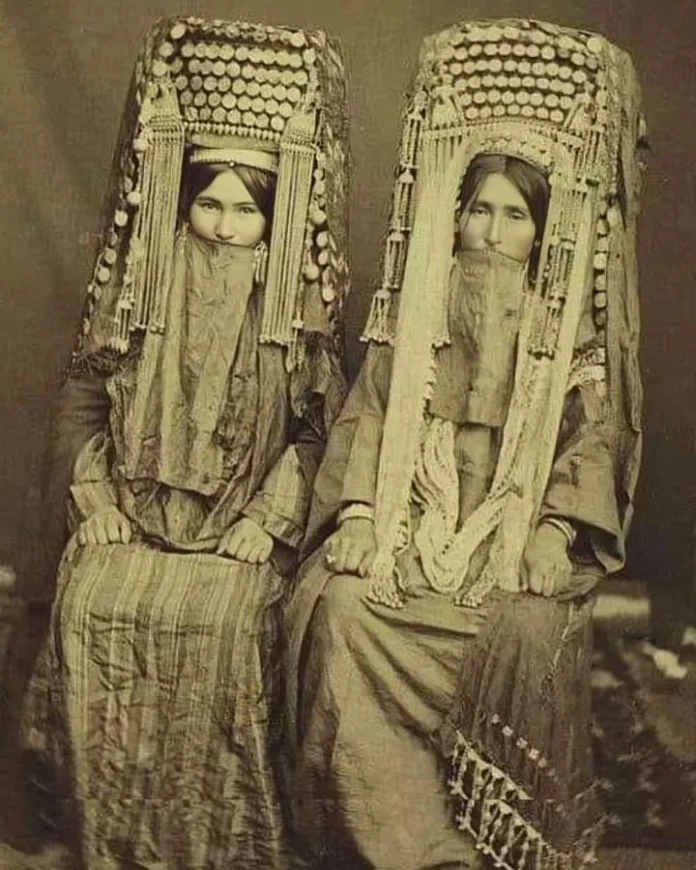In 1883, the coastal city of Krasnovodsk (now Turkmenbashi in Turkmenistan) was a vibrant hub for the Yomud confederation, a prominent group within the Turkoman tribes. These tribes, known for their rich history and unique cultural practices, have left an indelible mark on Central Asian history. One of the most fascinating aspects of their culture is the elaborate wedding costumes worn by Turkoman women.
A Glimpse into Turkoman History
The Turkomans are part of the larger Oghuz Turkic peoples, historically inhabiting regions in present-day Turkmenistan, Iran, Afghanistan, and Uzbekistan. The Yomud tribe, one of the main Turkoman groups, was renowned for its fierce independence and resistance to external domination, whether from Persian, Ottoman, or Russian empires.
By the 19th century, the Russian Empire had started to expand into Central Asia, culminating in the annexation of Turkoman territories. Despite this, the Yomud and other Turkoman tribes maintained many of their traditional practices, including their vibrant wedding rituals.
The Splendor of Turkoman Wedding Costumes
A Turkoman wedding was a grand affair, with the bride’s costume being the highlight. The wedding attire was not just about beauty but also about showcasing the tribe’s heritage and the family’s wealth. A typical bridal outfit included:
- Richly Embroidered Robes: Made from fine silk or cotton, the robes were intricately embroidered with patterns symbolizing prosperity and protection.

- Silver Jewelry: The bride adorned herself with heavy silver jewelry, including necklaces, bracelets, and headpieces. These pieces were often passed down through generations and were considered family heirlooms.

- Ala-kiyik (Head Covering): A large, colorful head covering that often included silver coins and beads, adding to the bride’s regal appearance.

- Yashmag (Face Veil): A delicate face veil, often decorated with silver ornaments, completed the ensemble.

The combination of these elements created a stunning visual spectacle, emphasizing both the beauty of the bride and the cultural richness of the Turkoman people.
Marriage Rituals and Religious Influences
Marriage among the Turkomans was not just a union of two individuals but a significant social event that reinforced tribal alliances and social bonds. The ceremonies were steeped in Islamic traditions, reflecting the Sunni Muslim faith that most Turkomans followed. The rituals included:

- Nikah Ceremony: An Islamic marriage contract was signed in the presence of witnesses, officiated by a religious leader known as a mullah.
- Kina Night: A pre-wedding celebration similar to a henna night, where the bride’s hands and feet were decorated with intricate henna designs.
- Bride Price (Kalym): The groom’s family would present gifts or money to the bride’s family, a practice that underscored the value of the bride and established a bond between the families.
The Influence of Russian Expansion
The late 19th century was a period of significant upheaval for the Turkomans, as the Russian Empire’s expansion into Central Asia brought profound changes. The conquest of Turkoman territories, including the Yomud lands, in the 1880s, led to increased Russian influence over local governance, trade, and daily life.
Despite these changes, many Turkoman traditions, including wedding customs, persisted. The resilience of their cultural practices in the face of external pressures is a testament to their strong sense of identity and heritage.
Legacy and Recognition
Today, the rich cultural tapestry of the Turkoman people is celebrated and preserved, both in Turkmenistan and among diaspora communities. The elaborate wedding costumes of Turkoman women remain a symbol of their enduring traditions and the historical journey of a proud and resilient people.

In essence, the wedding attire of Turkoman women in Krasnovodsk in 1883 encapsulates not only their aesthetic beauty but also the depth of their cultural and historical heritage. The fusion of intricate designs, precious materials, and meaningful rituals offers a window into the world of the Yomud and their place in Central Asian history.

